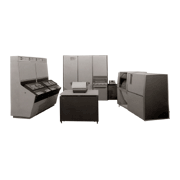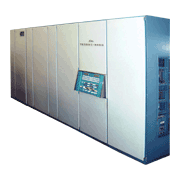Completed at the end of 1963 and announced the following year, the TOSBAC-3400 was a computer designed for scientific/engineering computing applications based on the KT-Pilot. It employed an asynchronous microprogram method that had been proven with the KT-Pilot. During development, Toshiba took advantage of this microprogram method — especially the ability to adjust the architecture to facilitate software development. Once completed, however, in order to ensure a broad software lineup, it eschewed the KT-Pilot’s architecture variability. To be price competitive as a commercial machine, fewer logic elements were used and speeds were boosted on the order of two or three magnitudes. The first unit was delivered to Toshiba’s Komukai Plant in 1964. At the time, the 3400 was promoted for scientific and engineering computing applications, but its application fields were greatly expanded with the introduction of the 20, 30, and 40 models, which offered business options through the addition of specific hardware modules. Later models were developed using faster, more reliable integrated semiconductor circuits for the arithmetic and control units. The 21 and 31 models were developed and released in 1968, the 41 model in 1969, and the 51 model in 1970. The 21 and 31 models had 14-bit memory addressing, but this was extended to 18 bits on the 41 and 51 models by using a base-address register and a relocation register. The 51 model had a switch, allowing it to run the 21 and 31 models’ operating system and programs without modification. The TOSBAC-3400 came with the FORTRAN compiler, the ALGOL compiler, the assembler, and other programs developed jointly with Kyoto University during the KT-Pilot project. The 3400 started out with the TOPS-1 operating system, which was extended into a TOPS operating system series. In 1967, a magnetic disk unit was connected to the 20 and 30 models, and TOPS-11 was developed as a disk-based operating system.

- Home >
- Historical Computers in Japan >
- Mainframes >
- TOSBAC 3400
All Rights Reserved, Copyright (C) Information Processing Society of Japan


